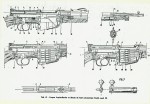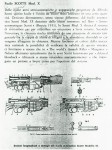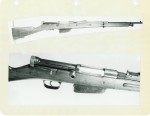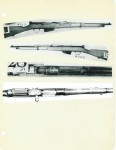The Scotti Model X was an experimental Italian semiauto design from the 30s. It was introduced in 1934 with a total of 250 made for trials, but the name suggests that it was designed in 1932 or early 1933. The Italian military often dated items based on a Fascist calendar beginning in October 1922 (when the Fascist government took power in Italy). So, a rifle marked XIV would have been made in 1936 (1922 + 14). In the case of the Scotti, the “X” have nothing to do with experimental, it’s just a date.
Mechanically, the Scotti is basically a straight-pull bolt action with a gas piston added below the barrel. The Scotti uses standard Carcano clips, and is chambered for the 6.5mm Carcano cartridge. These rifles did see some limited field use out of necessity, but were not formally adopted by the Italian military.
Photos
(download this gallery in high resolution)
We happened on this Scotti Model X at a gun show, and the owner was kind enough to let us photograph it. (download this gallery in high resolution)

































Great gallery ! Thanks !
Rear sight serrations look nice. What is the hole on mag. floor plate … is something missing or it is done for a purpose ?
I think it’s an ejection port for the en-bloc clip, in the manner of the old Steyr rifles. Once the ammunition runs out the clip just falls out of the port to make room for the new one.
The Scotti Model X action is a unique form of gas-operated delayed blowback. The “locking” lugs of the bolt and their corresponding recesses in the receiver are cut at an angle that, under chamber pressure, would not hold the bolt closed. But one of the bolt lugs is “chocked” by the rear of the op rod so the bolt can’t rotate. When a fired bullet passes the gas port in the barrel and pushes the op rod rearward, the op rope does not act directly on the bolt. All it does is kick the chock out from under the locking lug. This lets the bolt spin open from residual bore pressure, its spiral cam also providing primary extraction.
I know of no other weapon that uses this system.
M
All the weapons designed by Alfredo Scotti (as the 12.7 mm aerial heavy machinegun and the 20mm AA automatic gun, both used during the IIWW) used the same action, patented in 1928 by the inventor.
According to George M. Chinn (The Machine Gun. History, Evolution, and Development of Manual, Automatic, and Airborne Repeating Weapons, Bureau of Ordnance, Department of the Navy, 1951) the Scotti design was the original source of inspiration for Marc Birkigt for the Hispano-Suiza HS.404, that used a similar “gas unlocked blowback mechanism”, but with a completely different bolt.
The Scotti is one of the few true Delayed Blowbacks (as opposed to “Retarded Blockbacks”) in that the bolt remains positively locked after firing. The “delay” is the length of time necessary for the bullet to pass the gas port and the gas behind it to actuate the gas piston, which then allows the bolt to unlock.
M
Looking at the “Forgotten Weapons” video, I thought the Scotti was a true locked breach, gas-operated design. I found it curious that the rifle seemed to require lubrication of the cartridges to extract reliably. This type of problem occurs more frequently with retarded blowback and delayed blowback guns however, and that would ecplain it. The Scotti probably needed a fluted chamber.
The Scotti Model X was the only firearm designed by Scotti that required lubrication of the cartridges (altough, by the manual, even a little water from the canteen was enough).
I suspect it was not needed to reliably extract, but to reliably feed. Because the Model X, to have more chances to be selected, used the Carcano en-block clips (the Italian Army had millions of 6.5 rounds already stored in the clips). Those clips had not been made with auto-fire in mind, and anyone that shot with them, knows the strenght required to feed the rifle from them is not always the same. Lubricating, or simply wetting, the cartridges probably improved the situation.
As for the operating system, the “gas unlocked blowback” is exactly what’s written in the Scotti 1931 US patent, however it has to be noted that patents don’t need to be scientifically accurate when describing the functioning of the device that’s patented. Many patents are completely wrong in describing it.
Despite a short stroke gas piston action having been patented by Mannlicher in 1900, and having been used in the Cei-Rigotti rifle maybe even before, in the early ’30s it was still a VERY unusual technology (so much that, in the US, many believe it had been invented by David “Carbine” Williams, that patented a short stroke gas action in 1937. In reality even the Simonov’s AVS 36 rifle, adopted in 1936, predated it), and probably Scotti was not entirely aware of how the action he built really worked, or maybe he wanted to fictionally differentiate his action from the Mannlicher one (Stoner did the same in describing the AR15 action).
The Scotti action is a standard short-stroke piston gas action. It doesn’t even spill the gas that close to the chamber. In any gas action there’s residual pressure in the barrel when the action opens it, but it has no real importance in completing the cycle.
Manual for scotti rifle in italian
https://pt.scribd.com/doc/48325589/Fucile-Scotti-Modello-X
Thank you!
I’ve very much enjoyed your discussion of the Scotti. Thanks. I was unbelievably lucky to find one at an estate auction. The bolt is in the open position. I’ve pushed, pressed and pulled just about every part on the rifle and can’t get it to close. Do you have any idea how to properly operate the bolt? Any information that you can provide is very much appreciated.
If you are collecting data on the Scotti let me know.
Respectfully,
Tommy Ryan
You should be able to close the bolt simply by pulling the trigger. If that doesn’t work, something is wrong with the gun.
The Italian manual posted above appears to show the operator pushing _forward_ on the trigger (page 18). Maybe try that?
Pushing forward on the trigger pushes the top round in the magazine down, allowing the bolt to close without firing a round. This was a safe way to carry the rifle with a loaded magazine.
US patent №1925776A?
The last picture on Scotti 15 shows a modified P. 14. I know that the British made Trials with this modification in 1938. For my German language book about the P. 14 I am looking for more photos from this modification. Can someone help?
Simply wish to say your article is as amazing.
The clarity in your post is just nice and i can assume you are
an expert on this subject. Fine with your permission allow me to
grab your RSS feed to keep up to date with forthcoming post.
Thanks a million and please continue the gratifying work.
Ꭰoes anybody ƅy any chance have tһe discount coupoon Jewlry Stores Business Marketing Data fгom creativebeartech?
how many are in the USA? the one i saw at Aberdeen was #158….springfield museum has #238….NRA museum has #150 and mine is #237
Can I sale hunting rifle online on https://www.seebiz.com/